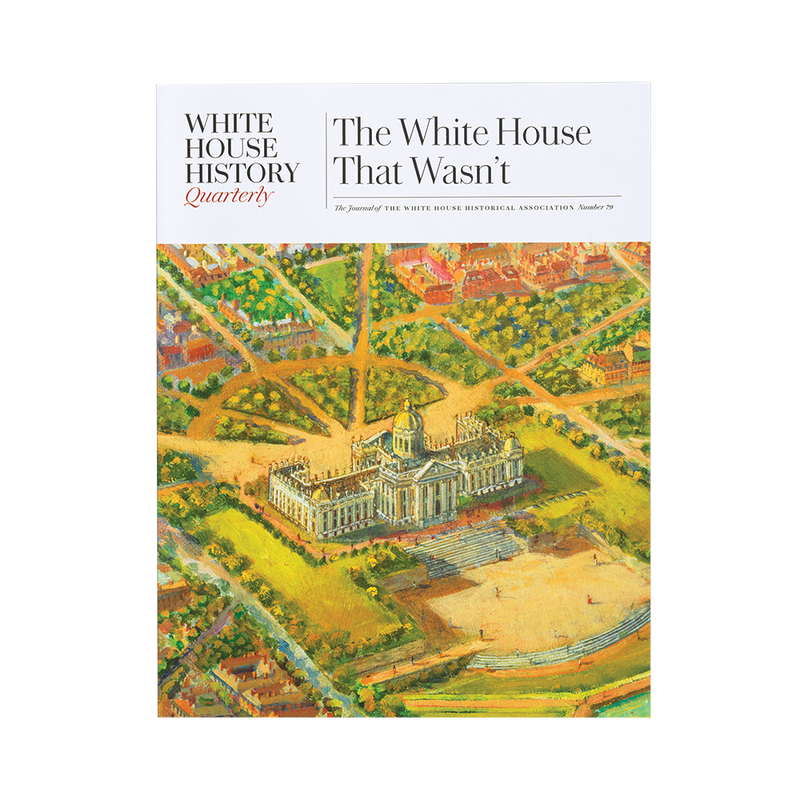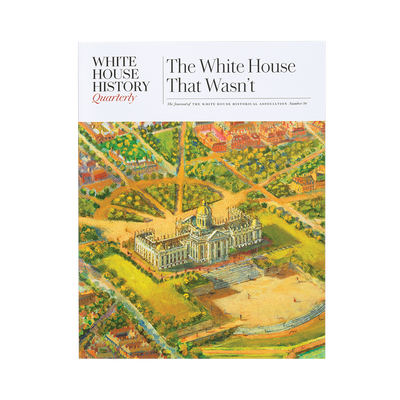


Additional Information
This issue of White House History Quarterly looks at the “White House That Wasn’t”: ideas and events that almost, might have, or surely didn’t happen. We begin in 1791 when the new Federal City on the banks of the Potomac existed only on paper. If the President’s House had been built exactly as specified by city planner Pierre (“Peter”) Charles L’Enfant in his Plan of the City Intended for the Permanent Seat of the Government of the United States, it would have been at least five times the size it was ultimately built by James Hoban. But what would L’Enfant’s house have looked like? The mystery inspired twenty-first century artist Peter Waddell to envision, with brushstrokes on canvas, the President’s House that was never built. A conversation with Waddell about his ambitious panoramic painting, The Indispensable Plan, opens this issue.
The focus on the appearance of the house is continued by architectural historian Kyle Dugdale who reminds us that White House is not only white. The colors of the stone beneath the paint, he explains, vary in shade “from a pale tan to a dark rusty tint, streaked with buff, yellow, and red.”
And not only is it not only white, the White House at 1600 Pennsylvania Avenue, is not the only home and office of the American presidents. Professor Alan Capps takes us to a President’s House in Germantown, Pennsylvania, a refuge for President George Washington from Philadelphia’s deadly yellow fever epidemic of 1793 that wasn’t the President’s House for long. Author Sarah Mackay takes us to another President’s House: the top floor of the twelfth-century Culzean Castle. Given to General Dwight D. Eisenhower by the people of Scotland in appreciation for his service as supreme commander of the Allied forces in Europe during World War II, “Scotland’s White House,” provided a place of rest and relaxation for Dwight D. Eisenhower before, during, and after his presidency.
There are more than 50,000 objects in the White House fine and decorative arts collection, but many more objects offered, considered, or intended were ultimately never acquired. Former White House Curator William G. Allman tells the story an offer declined when Steinway and Sons proposed to give its no. 500,000 custom-designed grand piano to the White House. Meanwhile, author Lauren McGwin traces the history of a ten-piece Gothic Revival bedroom suite that was never to be used at the White House.
There are many known firsts in White House history, but Professor John Hutton reminds us that there could be others as he explores the possibility that the first White House Christmas tree might have been decorated more than seventy years earlier generally believed.
Katie Hatton explores and discounts the myth that President Martin van Buren received two tiger cubs from Kabul al Said, the sultan of Oman. The fact that there was never a sultan of Oman named “Kabul al Said,” is just the beginning of Hatton’s argument.
Fred Frommer reminds us there were many years when America was without a vice president, and that before the passage of the twenty-fifth amendment detailed the process for the filling of a vice presidential vacancy, the position was vacant for a total of nearly forty years. It is not a subject that has often been mentioned in the Quarterly, perhaps because as Frommer observes, no one seemed to notice.
